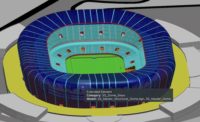
The 2021 Bipartisan Infrastructure Act, also known as the Infrastructure Investment and Jobs Act (IIJA), allocated $1.2-trillion for various projects, including roads, bridges, railways, waterways, internet access, and electrical grid improvements for both storage and transmission of power. The focus of the spending is not only on enhancing the nation's physical infrastructure but also on ensuring this money is spent wisely.
Technologies such as digital twins and contextual 3D models are emerging as powerful tools to maximize the efficiency of infrastructure investments, minimize costs and deliver superior results.
Infrastructure investment: Building the Future
Infrastructure investment has long been recognized as a cornerstone of economic growth in the natipon. The construction of the Eisenhower Interstate Highway System in the 1950s serves as a prime example, where new transportation infrastructure spurred suburban development and gave rise to thriving business centers. Today, reliable and efficient infrastructure remains vital for attracting businesses, supporting economic growth in both urban and rural areas, and enhancing the quality of life for all Americans. However, aging systems and inadequate infrastructure pose significant limitations on development potential while imposing substantial costs on states and individuals, especially with limitations caused by aging locks and dams on waterways, electrical grids that can't store energy from wind and solar generation sources and even highways that lack the electrical infrastructure to install charging stations near them.
How can we maximize the effectiveness of these investments? One possible answer lies in harnessing the power digital twin technology.
Driving Through Digital Twins
Digital twins have emerged as a transformative technology that promises to revolutionize infrastructure development and maintenance. Through highly accurate 3D models, digital twins provide comprehensive and interactive representations of physical structures, enabling stakeholders to gain a deeper understanding of projects and make more informed decisions. While numerous applications are being explored, the benefits of using digital twin technology in infrastructure projects are far-reaching:
- Ensuring Safety: Safety is the number one priority for infrastructure projects. Before the physical construction phase, 3D models can be used to simulate different scenarios and identify potential safety hazards. This proactive approach ensures that construction sites are safe for workers and future occupants.
- Avoiding costly mistakes: By utilizing up-to-date and precise 3D models, investors and developers can simulate various scenarios and test infrastructure designs before any physical construction begins. This early identification of potential issues minimizes costly changes and adjustments during the later stages of the project.
- Improving project outcomes: architects and designers can use digital twin technology to test concepts and simulate environmental conditions such as lighting and acoustics. This proactive approach enables them to spot problems early, facilitates necessary improvements, and ultimately leads to better project outcomes.
- Enhancing collaboration: Digital twins provide detailed and interactive representations of infrastructure, fostering improved communication and collaboration among stakeholders. This enhanced coordination ensures that all parties involved are aligned, mitigating misunderstandings and streamlining decision-making processes.
- Gaining Public Acceptance: Digital twins facilitate the creation of realistic and immersive virtual tours, allowing stakeholders to experience and understand infrastructure projects more effectively. This immersive visualization aids in securing public acceptance and support, particularly among those directly impacted by projects.
Operations and Maintenance
Beyond construction applications, digital twins hold immense potential for long-term cost savings in infrastructure maintenance. We spend enormous sums each year on inspecting and maintaining infrastructure, and deferring maintenance only exacerbates the problem. As everything from wastewater treatment plants to pipelines and refineries become more threatened to electronic attacks, operations and maintaining cybersecurity become even more important to these facilities.
A recent study by the Volcker Alliance suggests that delaying infrastructure repairs could cost the U.S. over $1 trillion. Digital twins enable ongoing monitoring and observation of infrastructure performance over time. By integrating additional data, engineers can simulate the impact of various factors, such as traffic or environmental conditions, allowing for predictive maintenance strategies. For instance, the use of digital twins in the Maharashtra Metro project in Nagpur, India, is projected to save over $222 million in the next 25 years through improved monitoring and maintenance.
As the U.S. embarks on a transformative phase of infrastructure investment, turning to cutting-edge technologies such as digital twins and contextual 3D models promises to maximize investment efficiency. By avoiding costly mistakes, improving project outcomes, enhancing collaboration, ensuring safety, and gaining public acceptance, digital twins enable stakeholders to make better-informed decisions and achieve superior results. Moreover, by revolutionizing infrastructure maintenance through ongoing monitoring and predictive maintenance strategies, digital twins can unlock significant cost savings in the long run.
As the nation builds the future, digital twins will be an indispensable tool in shaping a robust and resilient infrastructure that propels economic growth and enhances the lives of all Americans.
Nilson Kufus is Cofounder and CEO of Nomoko, a company that provides 3D data for digital twins






